The concept of portion control and meal frequency takes on a unique form when applied to the gluten-free Mediterranean diet. This way of eating is based on the traditional cuisines of countries bordering the Mediterranean Sea but adapted for individuals who cannot consume gluten due to celiac disease or gluten sensitivity. The diet emphasizes the consumption of vegetables, fruits, whole grains, legumes, nuts, seeds, and olive oil, with moderate amounts of fish, poultry, and dairy. This dietary pattern naturally lends itself to a structure that promotes varied portion sizes and regular meal frequency, aligning with principles of health and satiety.

Adapting the Mediterranean diet to be gluten-free involves careful consideration of ingredients to avoid gluten contamination while still benefiting from the diet’s nutritional richness. For those managing celiac disease or gluten sensitivity, it’s not just about choosing gluten-free alternatives but also about the quality and quantity of food. Portion sizes and the frequency of meals play crucial roles in maintaining overall health, managing weight, and ensuring that the body gets a steady supply of energy and nutrients throughout the day. The gluten-free Mediterranean diet allows for flexibility and encourages individuals to listen to their body’s signals, eating when hungry and stopping when full, which highlights the importance of mindful eating practices.
Key Takeaways
- Portion sizes on a gluten-free Mediterranean diet are adaptable to individual needs and hunger cues.
- Meal frequency should be regular and in line with personal energy requirements.
- Careful ingredient selection is important to maintain a balanced and nutritious gluten-free diet.
Table of Contents
Understanding the Gluten-Free Mediterranean Diet
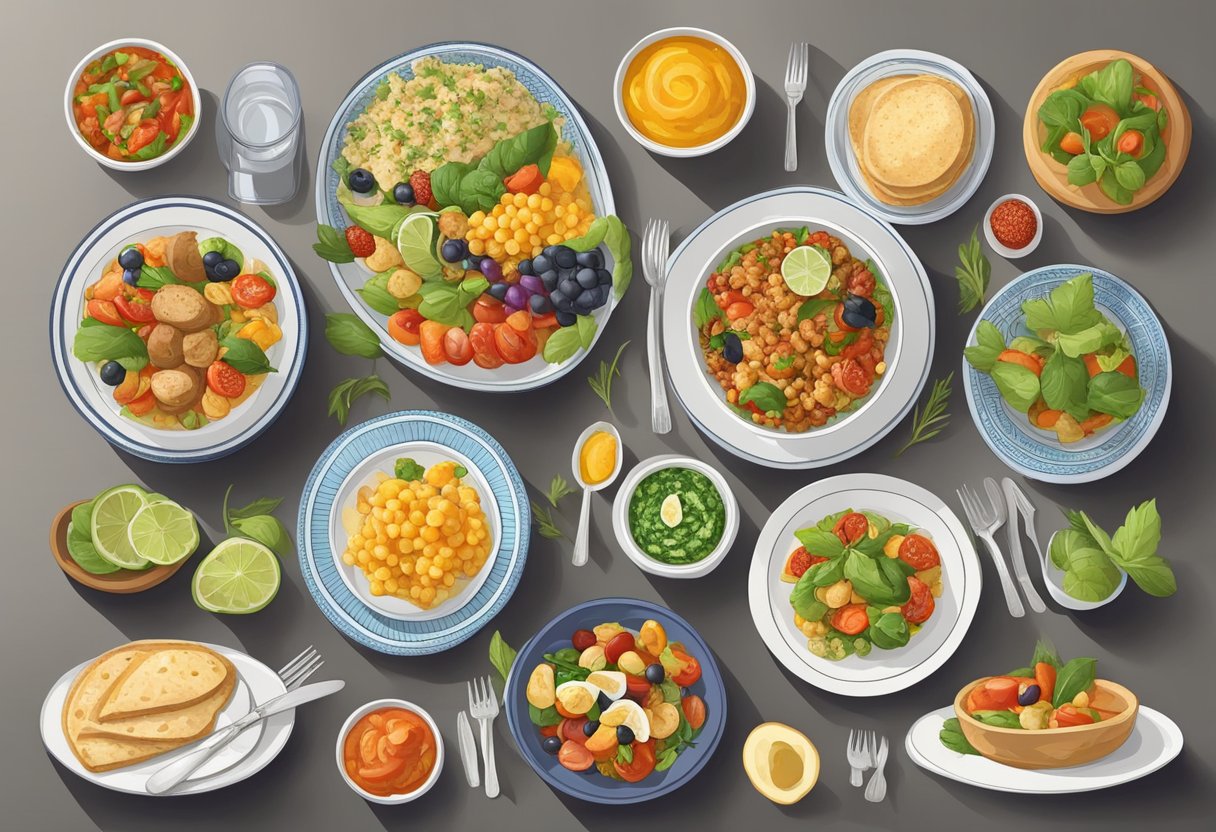
The Gluten-Free Mediterranean Diet merges the heart-healthy principles of Mediterranean eating with the dietary needs of individuals with celiac disease or gluten sensitivity. This diet emphasizes whole grains, fruits, vegetables, nuts, and healthy fats, all of which are naturally gluten-free and intrinsic to Mediterranean cuisine.
Core Principles of Mediterranean Eating
The Mediterranean diet is centered around a variety of key components that promote overall health and may help reduce the risk of chronic diseases such as heart disease, cancer, and type 2 diabetes.
- Whole Grains: Integral to the diet, options include gluten-free varieties such as quinoa and brown rice.
- Vegetables and Fruits: These are the cornerstone of each meal, providing essential vitamins, minerals, and fiber.
- Nuts and Seeds: A source of protein and healthy fats, they should be consumed regularly but in moderate portions due to high caloric density.
- Olive Oil: Used as the main source of fat, offering anti-inflammatory properties and monounsaturated fats.
- Fish and Seafood: Encouraged at least twice a week, fish provides omega-3 fatty acids beneficial for heart health.
- Dairy: Consumed in moderation, options include Greek yogurt and cheese, which offer protein and calcium.
The diet also limits processed foods, red meat, and sweets, encouraging a high intake of natural, nutrient-dense foods for a balanced anti-inflammatory diet.
Defining Gluten-Free Needs
For those with celiac disease or gluten intolerance, avoiding gluten—a protein found in wheat, barley, and rye—is critical. Gluten-free needs require:
- Careful Selection of Grains: Selecting grains that are inherently gluten-free, such as millet, sorghum, and amaranth.
- Avoiding Cross-Contamination: Ensuring that foods are not contaminated with gluten during processing or preparation.
- Label Reading: Diligently checking food labels for hidden sources of gluten.
Following a gluten-free diet helps prevent the inflammation and intestinal damage caused by celiac disease, and when coupled with Mediterranean principles, can support overall health and reduce the risk of developing other chronic diseases.
Creating a Balanced Gluten-Free Mediterranean Meal Plan
Creating a balanced meal plan that adheres to the principles of the Mediterranean diet while also being gluten-free requires thoughtful consideration of daily routines and the inclusion of a variety of nutrient-dense foods.

Designing a Daily Eating Routine
A structured eating routine is fundamental to maintaining a balanced diet. When one follows a Mediterranean diet meal plan, it typically involves having three main meals—breakfast, lunch, and dinner—with the option of one or two small snacks. Consistency in meal timing helps regulate appetite and energy levels throughout the day.
Incorporating Nutrient-Dense Foods
The core of a gluten-free Mediterranean meal plan is built on whole foods. Emphasizing gluten-free whole grains like quinoa and oats, along with a variety of vegetables, fruits, legumes, and nuts, ensures a diet rich in fiber, protein, and healthy fats. These foods are not only nutrient-dense but also contain abundant antioxidants that support overall health.
- Grains: Choose gluten-free options like quinoa, which is a complete protein, and steel-cut oats.
- Vegetables: Incorporate a rainbow of vegetables each day.
- Fruits: Opt for whole fruits to maximize fiber intake.
- Proteins: Include legumes and nuts for plant-based proteins.
- Fats: Utilize olive oil as a healthy fat in cooking and dressings.
Gluten-Free Mediterranean Diet Recipes
Preparing recipes that align with a gluten-free Mediterranean diet requires selecting ingredients that provide the same health benefits without the gluten. Options like quinoa tabbouleh, grilled vegetables, and chickpea salads can be the cornerstone of lunch and dinner, while breakfast might include chia seed pudding or gluten-free oatmeal with nuts and fruits.
Balancing Calories and Portion Sizes
Understanding portion sizes and their corresponding calories is critical for balancing energy intake. A modest amount of whole grains, such as ½ cup of cooked quinoa, and a handful of nuts can provide sustained energy without excessive calories. The focus should be on filling half of the plate with a variety of colorful vegetables, ¼ with lean proteins or legumes, and the remaining ¼ with whole grains.
- Vegetables: Aim for 2-3 cups per meal.
- Proteins: A standard serving is about the size of a deck of cards.
- Whole Grains: Limit to a ½ cup cooked per meal.
- Fats: Use 1 tablespoon of olive oil as a serving guide.
Dealing with Specific Meals and Ingredients
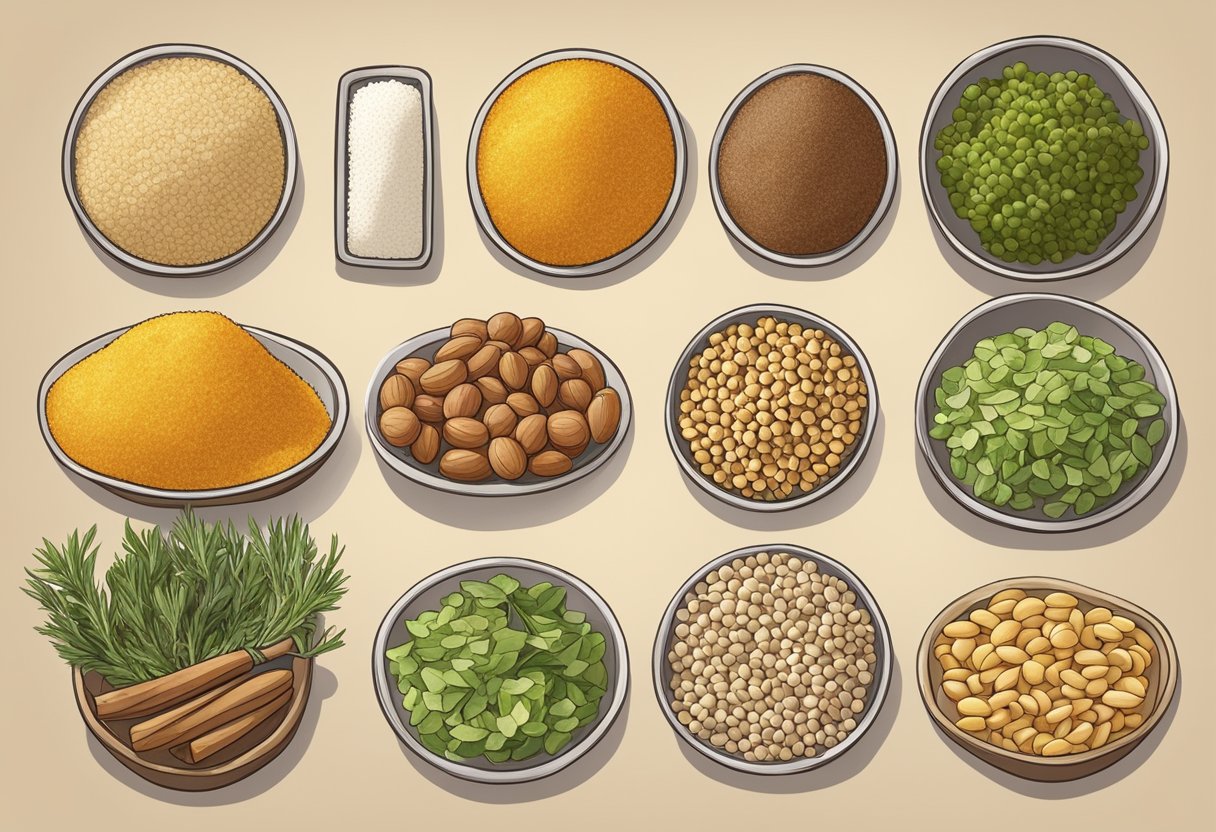
Crafting meals within a gluten-free Mediterranean diet focuses on whole foods, such as fruits, vegetables, whole grains, and lean proteins, while ensuring gluten is absent from the ingredients. Proportions and meal composition are key for maximizing nutritional value.
Breakfast Options
For breakfast, options can include a bowl of gluten-free oatmeal topped with a mix of fresh berries and nuts, providing fiber, vitamins, and healthy fats. Another choice could be a quinoa fruit salad drizzled with olive oil and lemon juice for a refreshing start to the day.
Healthy Lunch Ideas
Lunch may feature a vibrantly colored salad with leafy greens, a variety of vegetables, chickpeas, and grilled fish, such as salmon. Dressing with extra virgin olive oil adds heart-healthy fats. Alternatively, one could opt for a gluten-free rice or corn pasta salad with beans, lentils, and plenty of vegetables.
Dinner Compositions
A dinner composition might highlight grilled or baked fish or other lean proteins accompanied by a side of roasted vegetables and a serving of gluten-free grains, like quinoa or wild rice. Utilizing herbs and spices for flavoring enhances dishes without adding gluten.
Choosing the Right Snacks
For snacks, individuals can turn to whole fruits, nuts, or gluten-free rice cakes topped with olive oil and tomato slices. These choices maintain balance and align with portion control principles while being suitable for individuals on a gluten-free diet.
Shopping and Preparation Tips
Successfully adhering to a gluten-free Mediterranean diet begins with strategic shopping and meal preparation. Attention to detail is critical when selecting ingredients to ensure they meet dietary needs while still providing the nutritional benefits of the Mediterranean lifestyle.
Reading Labels for Gluten and Additives
Consumers should diligently read labels for hidden gluten sources and unnecessary additives in products. It’s important to look for terms like “wheat,” “barley,” “rye,” or “malt,” which indicate gluten presence. Additionally, one should seek out certifications like “Certified Gluten-Free” to ensure safety.
Strategic Grocery Shopping
Creating a detailed grocery list that aligns with Mediterranean diet recipes can streamline shopping and reduce the risk of buying processed items. Individuals may consult a registered dietitian to curate a list that features a variety of fruits, vegetables, whole grains that are gluten-free, lean proteins, and healthy fats like olive oil.
- Fruits: Apples, Berries, Oranges
- Vegetables: Spinach, Bell Peppers, Tomatoes
- Proteins: Chicken, Fish, Hummus
- Whole Grains: Quinoa, Brown Rice, Gluten-Free Oats
- Healthy Fats: Olive Oil, Avocado, Nuts
Prepping Meals Ahead of Time
Meal preparation can involve pre-cooking whole grains and chopping vegetables to save time. Pre-portioned meals can aid in maintaining appropriate portion sizes and reduce the temptation of processed snacks. Tips for meal prep include:
- Cook grains in large batches
- Wash and cut veggies for easy access
- Prepare homemade hummus for a quick snack
- Leveraging Mediterranean diet recipes designed for batch-cooking
By focusing on these key shopping and preparation tips, individuals can navigate a gluten-free Mediterranean diet with confidence and ease.
Managing Health with the Diet

Embracing the gluten-free Mediterranean diet can contribute to holistic health management, focusing on reducing chronic illness risks while promoting overall well-being.
Potential Health Benefits
The gluten-free Mediterranean diet is celebrated for its plethora of health benefits, particularly its association with reduced rates of heart disease and certain types of cancer. Rich in omega-3 fatty acids, the diet endorses regular consumption of fish, which supports cardiovascular health by maintaining healthy blood pressure levels and reducing inflammation, an underlying factor in chronic diseases. Inclusion of foods high in fiber, such as fruits, vegetables, and legumes, not only facilitates weight management but may also decrease the risk of developing type 2 diabetes.
Addressing Food-related Health Issues
People diagnosed with celiac disease or non-celiac gluten sensitivity can consult a registered dietitian to adapt the traditional Mediterranean diet to a gluten-free variant. This adaptation helps manage symptoms and nutritional needs post-diagnosis, as the diet naturally includes many gluten-free foods. The anti-inflammatory benefits of the diet might also have positive implications for managing autoimmune conditions and neurodegenerative diseases, like Alzheimer’s disease. The Celiac Disease Foundation recommends a gluten-free diet as the primary treatment for those with celiac disease, emphasizing the importance of a tailored diet plan developed with a healthcare professional.
Beyond the Plate: Lifestyle Considerations
Adopting a gluten-free Mediterranean diet is not only about food choices; it also necessitates a holistic approach to lifestyle, embracing regular physical activity and addressing emotional eating to achieve comprehensive wellbeing.
Incorporating Physical Activity
The region surrounding the Mediterranean Sea is renowned for a lifestyle that naturally integrates ample physical activity. For those on a gluten-free Mediterranean diet, it’s beneficial to include a variety of exercises such as:
- Aerobic activities: brisk walking, swimming, or cycling, for a minimum of 150 minutes a week.
- Strength training: twice a week, focus on major muscle groups using weights or resistance bands.
Understanding Emotional Eating
Emotional eating can be an obstacle to maintaining any nutritious diet, including the gluten-free Mediterranean diet. Recognizing emotional triggers that lead to overeating and replacing them with stress management techniques is crucial. They may find comfort in:
- Short meditative practices or deep-breathing exercises.
- Engaging in a creative hobby or spending time in nature to divert the mind from stress-induced cravings.
Culinary Exploration and Experimentation
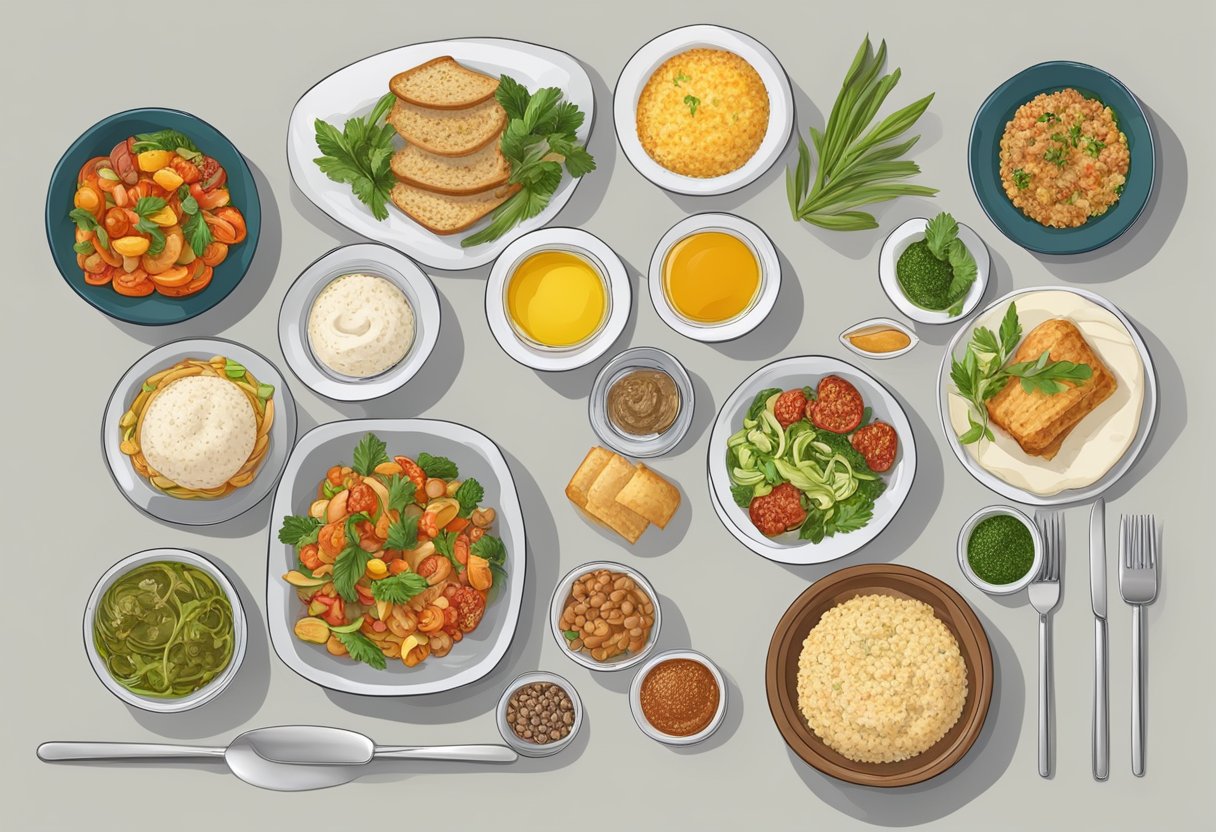
The gluten-free Mediterranean diet offers ample opportunity for innovation in the kitchen. Adapting to this lifestyle requires creativity in revisiting traditional recipes and incorporating new, international flavors to compose a tailored collection of dishes.
Adapting Traditional Recipes
Adapting Mediterranean diet recipes to be gluten-free often means substituting common grains with gluten-free alternatives like quinoa. A traditional tabbouleh, for instance, can be transformed by using quinoa instead of bulgur, maintaining its authenticity with plenty of fresh herbs, olive oil, and lemon juice. Similarly, gluten-free pasta can serve as the base for a Greek pasta salad, enriched with feta cheese, olives, and fresh vegetables.
Exploring International Flavors
The Mediterranean palate is rich with herbs and spices that can be used to infuse dishes with robust flavors, without relying on gluten-containing elements. People can experiment with international blends to season proteins like salmon, which can be grilled and drizzled with olive oil and herbs for a simple yet flavorful meal. Additionally, chickpea salad offers a versatile canvas to incorporate international spices, whether one is aiming for a za’atar seasoning or a Moroccan-inspired cumin and coriander combination.
Creating a Personalized Recipe Collection
Individuals following a gluten-free Mediterranean diet should consider building a personal recipe collection, focusing on foods such as Greek yogurt for breakfast or snacks and yogurt-based sauces that can accompany various dishes. They can also test different types of cheese, exploring how a sharp cheese variety changes the profile of a stuffed bell pepper, or what a sprinkle of feta adds to roasted vegetables. Aim to create a mix of recipes that are both enjoyable and adhere to dietary requirements, thus establishing a personal gluten-free Mediterranean diet repertoire.
Community and Support for a Gluten-Free Mediterranean Lifestyle
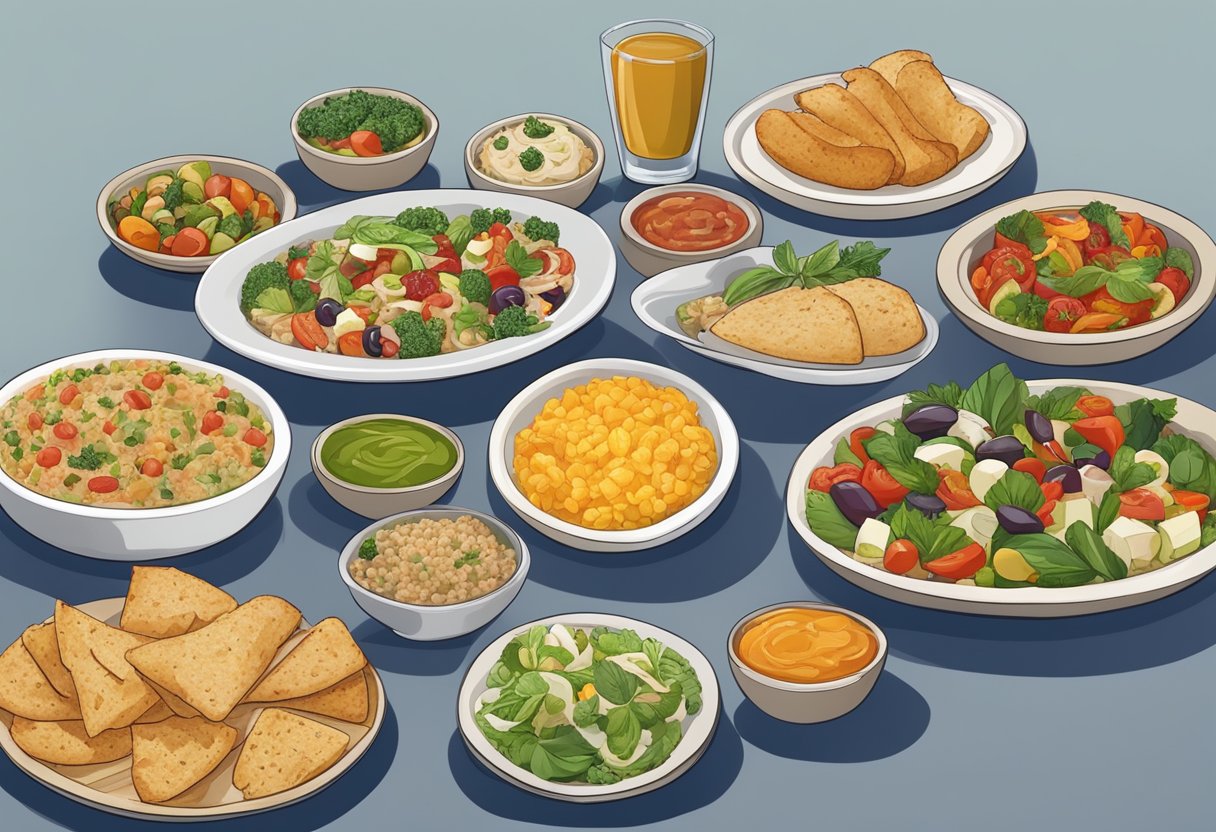
Adopting a gluten-free Mediterranean diet can be a fulfilling journey, but it’s one that doesn’t have to be walked alone. With the rise of dietary awareness and platforms for community engagement, individuals can find solace and practical tips through dedicated support groups and inclusive dining options.
Finding Support Groups
Support groups play a crucial role in the management and enjoyment of a gluten-free Mediterranean lifestyle. Organizations like the Celiac Disease Foundation offer resources and community connections for individuals seeking guidance and camaraderie. These groups often share tips on meal planning, recipes, and ways to adhere to dietary restrictions without compromising on taste or nutritional value. They are an essential asset for newcomers and seasoned dieters alike, fostering an environment where one can exchange ideas and gain confidence in managing their diet.
Navigating Dining Out
Enjoying a meal out on a gluten-free Mediterranean diet can be a gratifying experience when equipped with the right knowledge. Many restaurants now cater to special dietary needs, and some even offer dedicated gluten-free menus. People with celiac disease or gluten sensitivity can engage with local dining establishments or online community groups to uncover eateries that accommodate the Mediterranean diet’s focus on fresh, unprocessed foods. In addition, individuals often share their dining out experiences, which can serve as a reliable guide for others in the community seeking to enjoy social eating occasions without stress.
Staying Informed on Gluten-Free Mediterranean Eating
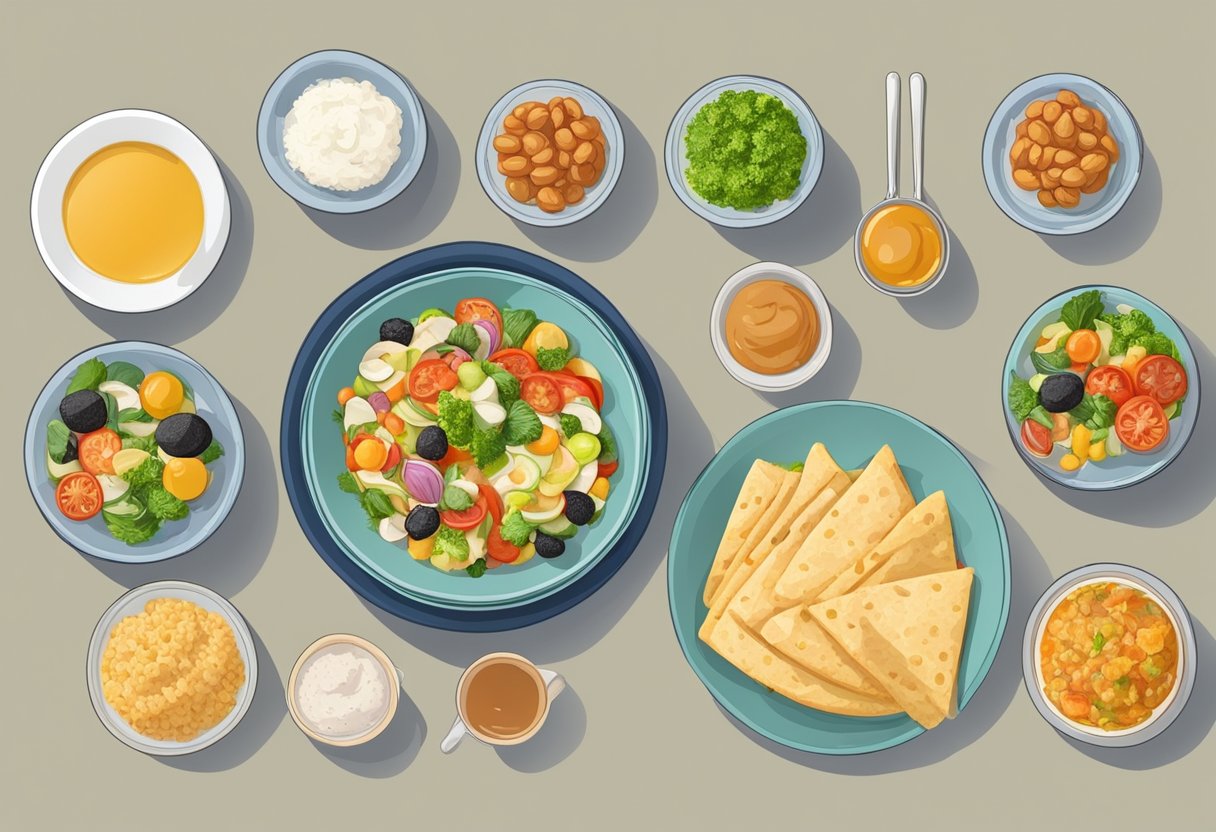
Adopting a gluten-free Mediterranean diet requires not only an understanding of the food choices but also ongoing education and reliable resources. This section offers guidance on how to remain well-informed about this eating pattern, which is crucial for individuals with celiac disease or those looking to maintain a healthy gluten-free lifestyle.
Continuing Education
Continuing education is vital for anyone following a gluten-free Mediterranean diet, especially since research and food products are regularly updated. Individuals are encouraged to seek opportunities for learning, such as workshops, webinars, and reputable online courses. These resources often help one learn how to incorporate a variety of nutrient-dense foods like fruits, vegetables, legumes, and healthy fats into their diet while ensuring that they maintain strict gluten-free compliance.
Following Reputable Sources
Choosing reputable sources is crucial for accurate and safe dietary practices. It is highly recommended for individuals to follow the guidance of a registered dietitian who specializes in celiac disease and the gluten-free Mediterranean diet. Verified online platforms such as Beth Israel Deaconess Medical Center can provide trustworthy information on the guidelines and health benefits of the diet. Such sources are assets for staying abreast of nutritional science and culinary trends associated with Mediterranean gluten-free eating.
Conclusion

The gluten-free Mediterranean diet stands as a balanced approach to eating that emphasizes whole foods and minimizes processed items. Those who adhere to this diet can enjoy a variety of nutrient-dense foods that support a healthy lifestyle. This dietary pattern encourages:
- High intake of vegetables, fruits, whole grains, and legumes
- Healthy fats, predominantly from sources like olive oil
- A moderate consumption of seafood, poultry, and dairy
- Minimal intake of sweets and processed or red meats
Adopting small, frequent meals throughout the day aligns well with a Mediterranean diet framework and can aid in maintaining energy and blood sugar levels, especially important for those managing gluten-related disorders.
In terms of sustainable eating, the diet’s focus on plant-based foods and seasonal produce minimizes the ecological footprint, making it a viable option for those concerned with environmental impact.
It is important for individuals to adjust their portion sizes according to their specific needs, ensuring they obtain all necessary nutrients while adhering to a gluten-free requirement. By focusing on fresh, whole foods and maintaining balanced meals, the gluten-free Mediterranean diet can be a fulfilling path toward optimal health and wellness.
Frequently Asked Questions
Adapting to a gluten-free Mediterranean diet requires understanding suitable substitutions and meal frequency to maintain a balanced diet.
How can one adapt traditional Mediterranean diet meals to be gluten-free?
One can adapt traditional Mediterranean dishes by replacing ingredients containing gluten with alternatives such as gluten-free grains and using gluten-free condiments.
What types of gluten-free grains are typically included in a Mediterranean diet?
Typically, gluten-free grains like quinoa, rice, and oats are incorporated into the Mediterranean diet to replace wheat, barley, and rye.
How frequently should meals be consumed on a Mediterranean diet that is also gluten-free?
Individuals should consume three well-balanced meals daily, with the option for healthy snacks, ensuring consistent energy levels and nutrient intake throughout the day.
What are suitable gluten-free substitutions for common Mediterranean diet staples?
Substitutes include gluten-free pasta for traditional pasta and wheat-free versions of pita bread, along with using gluten-free grains as the base for dishes that traditionally use couscous or farro.
What portion sizes are recommended for a balanced gluten-free Mediterranean diet?
A balanced gluten-free Mediterranean diet recommends moderate portion sizes, focusing on high amounts of fruits and vegetables, lean proteins, and gluten-free grains, with healthy fats in moderation.
What is a typical gluten-free Mediterranean diet breakfast consist of?
A typical breakfast might consist of gluten-free whole grains like amaranth or buckwheat, along with mixed berries, nuts, and low-fat Greek yogurt.



